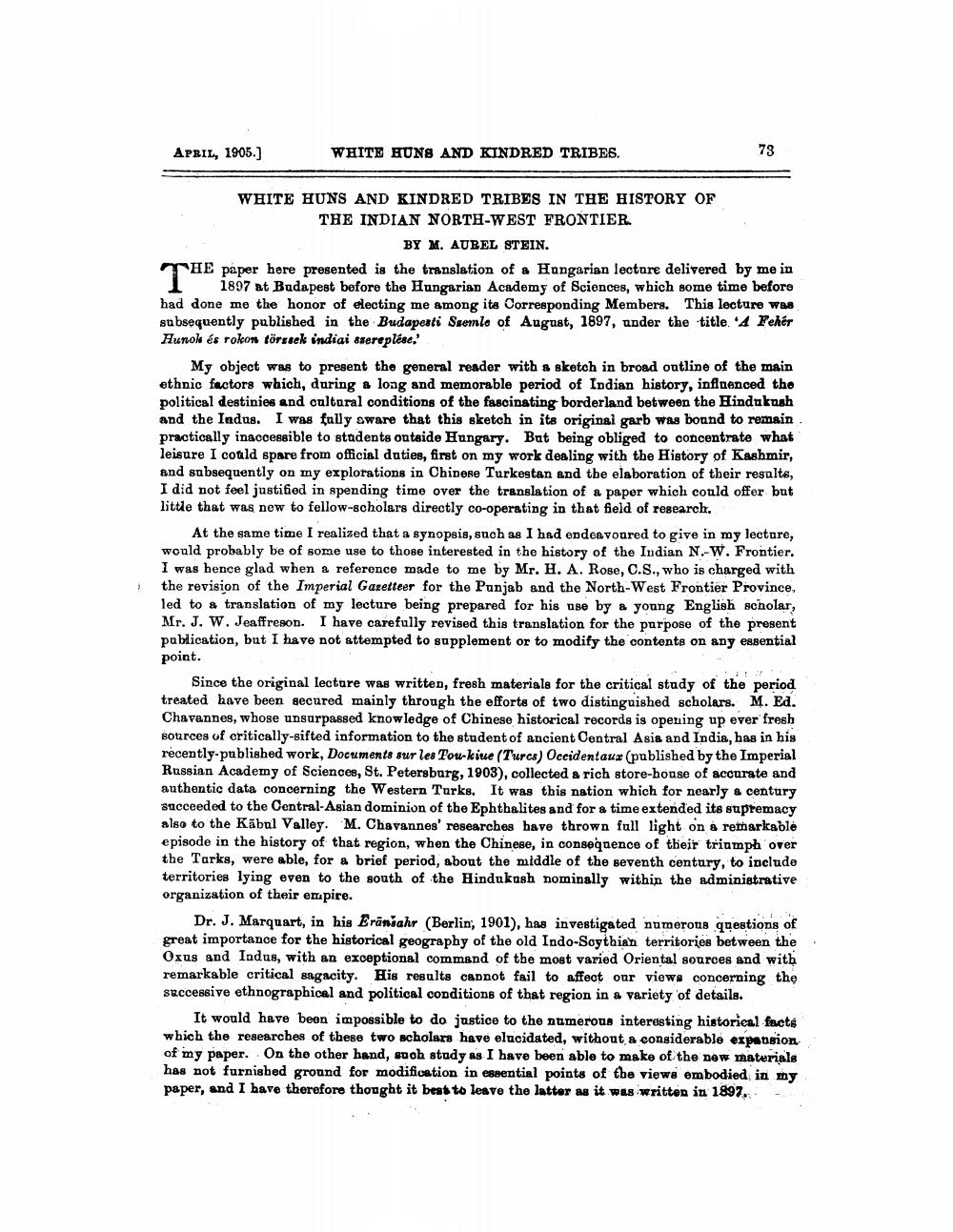________________
APRIL, 1905.)
WHITE HUNS AND KINDRED TRIBE6.
73
WHITE HUNS AND KINDRED TRIBES IN THE HISTORY OF THE INDIAN NORTH-WEST FRONTIER.
BY M. AUREL STEIN. THE paper here presented is the translation of a Hungarian lecture delivered by me in
1 1897 at Budapest before the Hungarian Academy of Sciences, which some time before had done me the honor of electing me among its Corresponding Members. This lecture was subsequently published in the Budapesti Ssemle of August, 1897, under the title. '4 Fehér Hunol és rokon törzsek indiai tsereplése.'
My object was to present the general reader with a sketch in broad outline of the main ethnic factors which, during a long and memorable period of Indian history, influenced the political destinies and cultural conditions of the fascinating borderland between the Hindukash and the Indus. I was fully aware that this sketch in its originai garb was bound to remain practically inaccessible to students outside Hungary. But being obliged to concentrate what leisure I could spare from official duties, first on my work dealing with the History of Kashmir, and subsequently on my explorations in Chinese Turkestan and the elaboration of their results, I did not feel justified in spending time over the translation of a paper which could offer but little that was new to fellow-scholars directly co-operating in that field of research,
At the same time I realized that a synopsis, such as I had endeavoured to give in my lecture, would probably be of some use to those interested in the history of the Indian N.-W. Frontier. I was hence glad when a reference made to me by Mr. H. A. Rose, C.S., who is charged with the revision of the Imperial Gazetteer for the Punjab and the North-West Frontier Province, led to a translation of my lecture being prepared for his use by a young English scholar, Mr. J. W. Jenffreson. I have carefully revised this translation for the purpose of the present publication, but I have not attempted to supplement or to modify the contents on any essential point.
Since the original lecture was written, fresh materials for the critical study of the period treated have been secured mainly through the efforts of two distinguished scholars. M. Ed. Chavannes, whose unsurpassed knowledge of Chinese historical records is opening up ever fresh sources of critically-sifted information to the student of ancient Central Asia and India, has in his recently published work, Documents sur les Fou-kiue (Turcs) Occidentaux (published by the Imperial Russian Academy of Sciences, St. Petersburg, 1903), collected a rich store-house of accurate and authentic data concerning the Western Turks. It was this nation which for nearly a century succeeded to the Central-Asian dominion of the Ephthalites and for a time extended its supremacy also to the Kābul Valley. M. Chavannes' researches have thrown full light on a remarkable episode in the history of that region, when the Chinese, in consequence of their triumph over the Tarks, were able, for a brief period, about the middle of the seventh century, to include territories lying oven to the south of the Hindukush nominally within the administrative organization of their empire.
Dr. J. Marquart, in his Erānšahr (Berlin, 1901), has investigated numerous questions of great importance for the historical geography of the old Indo-Soythian territories between the Oxus and Indus, with an exceptional command of the most varied Oriental sources and with remarkable critical sagacity. His results cannot fail to affect our views concerning the Successive ethnographical and political conditions of that region in a variety of details.
It would have been impossible to do justice to the numerous interesting historical facts which the researches of these two scholars have elucidated, without a considerable expansion of my paper. On the other hand, such study as I have been able to make of the new materials has not furnished ground for modification in essential points of the views embodied in my paper, and I have therefore thought it beat to leave the latter as it was written in 1897. -




